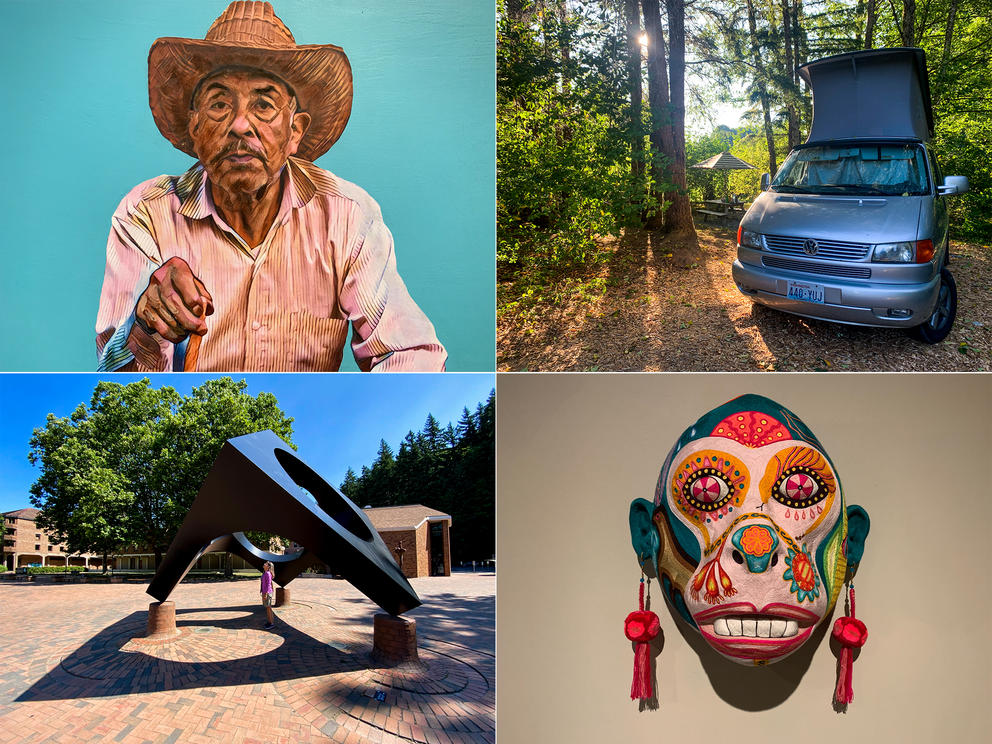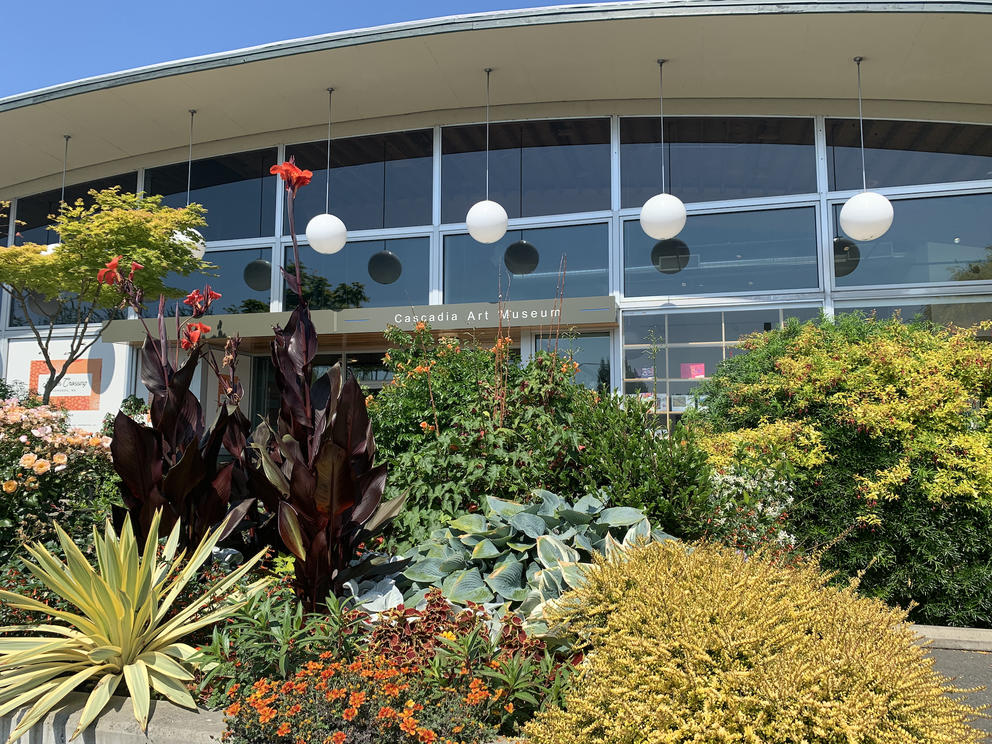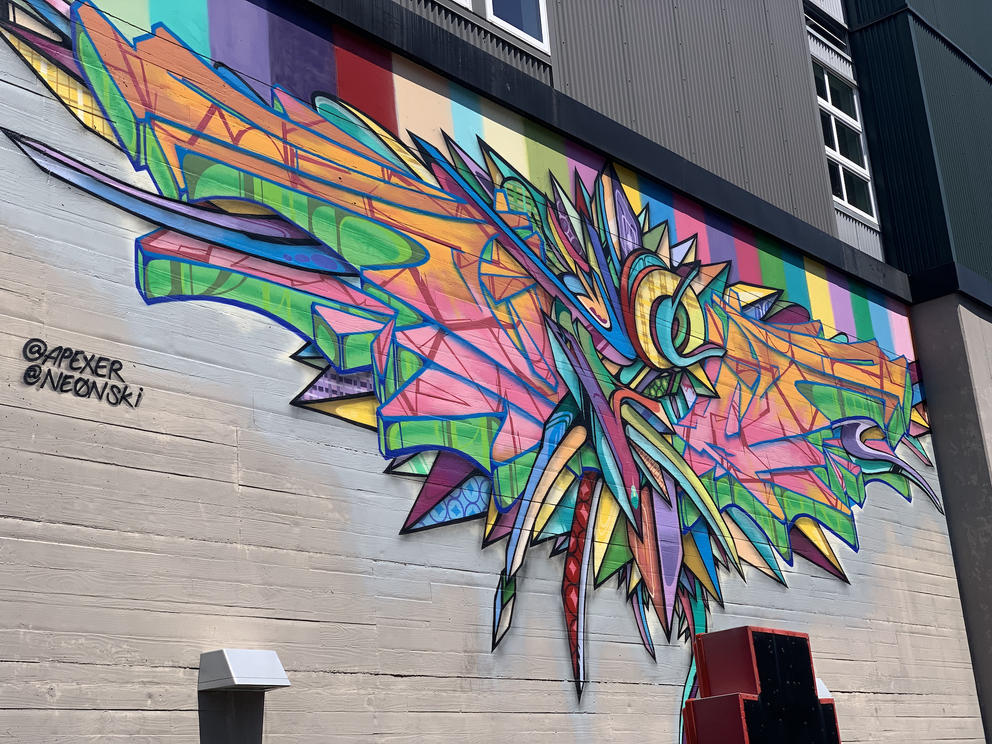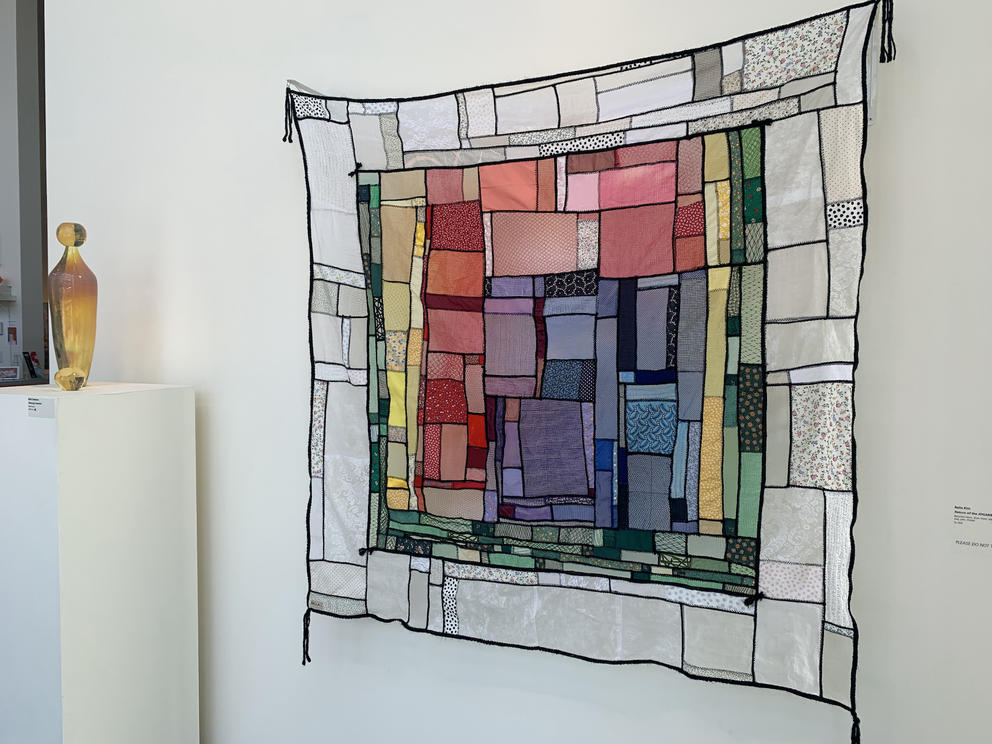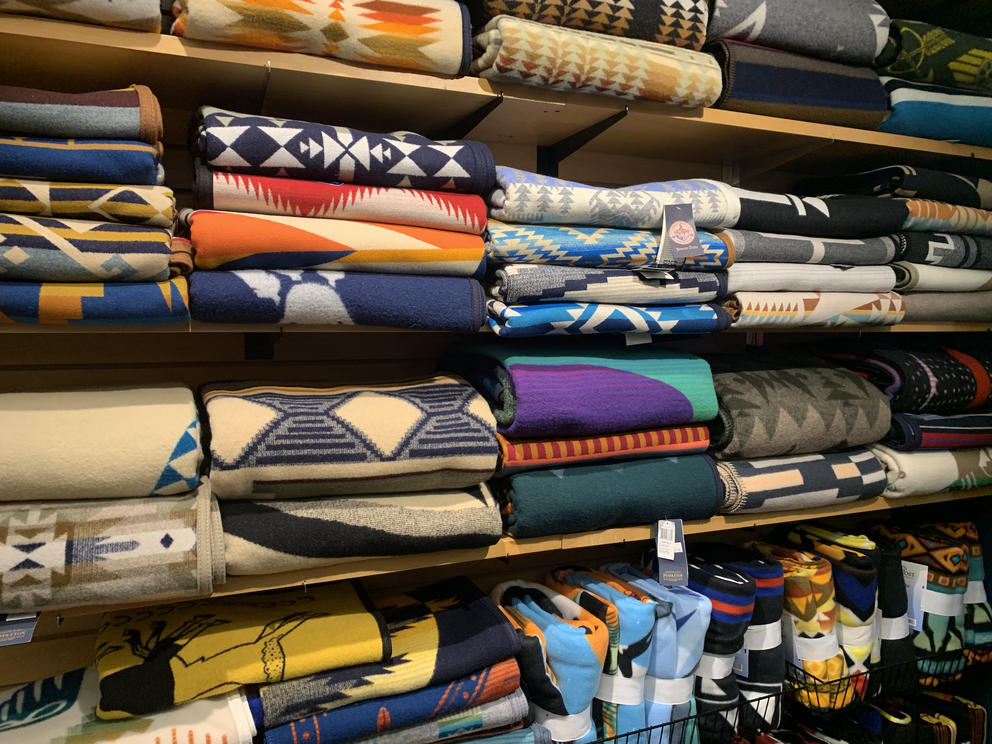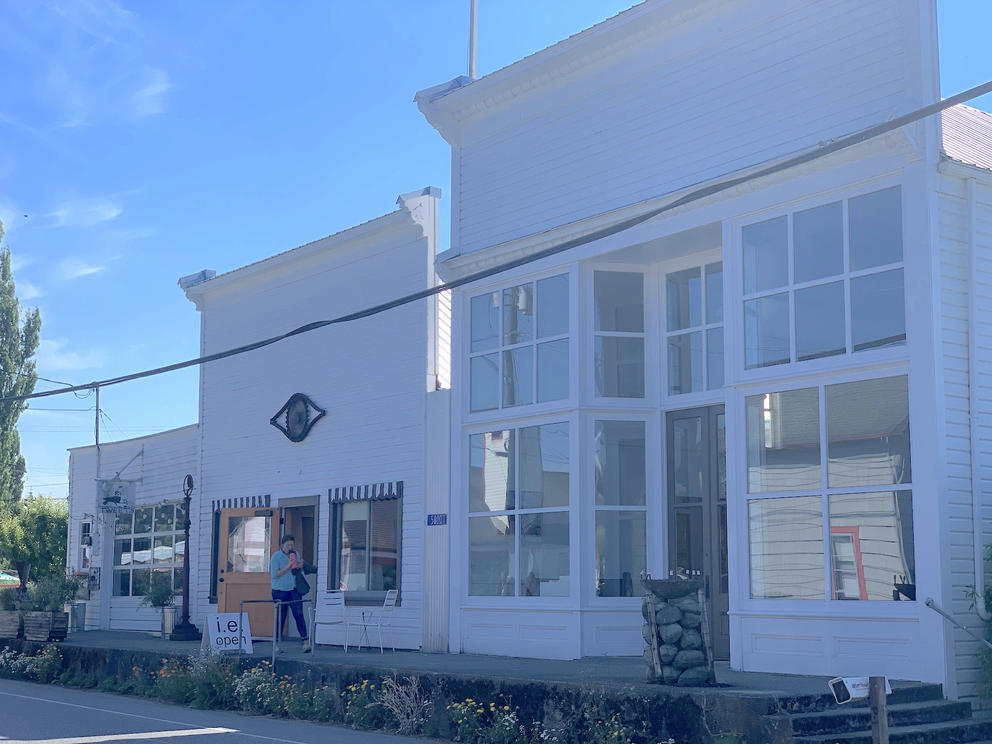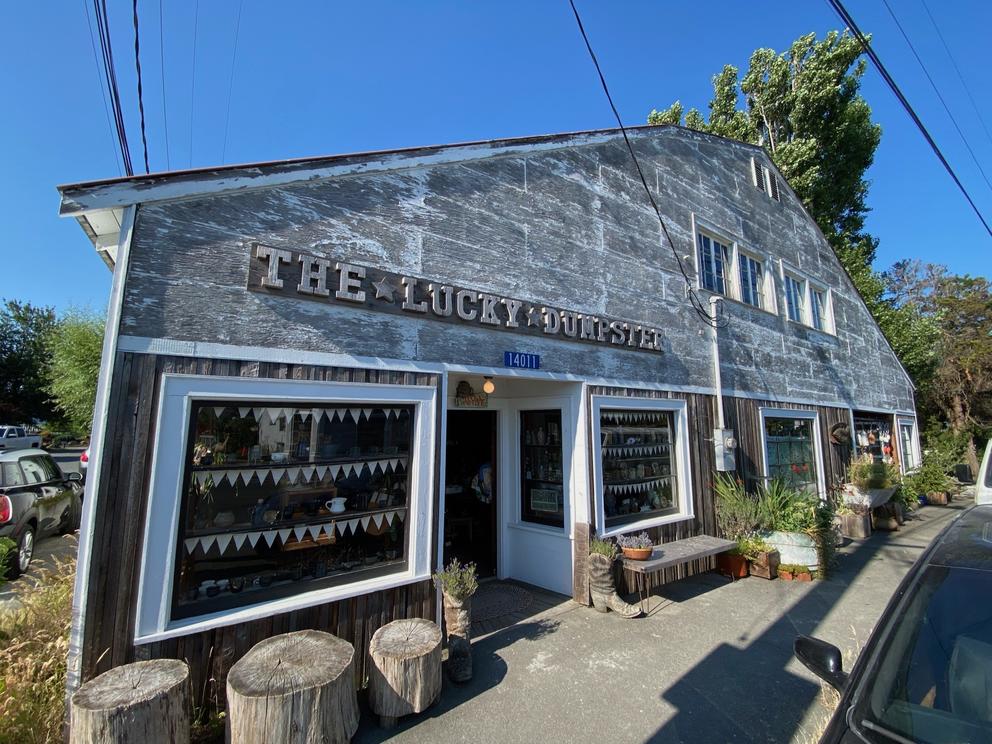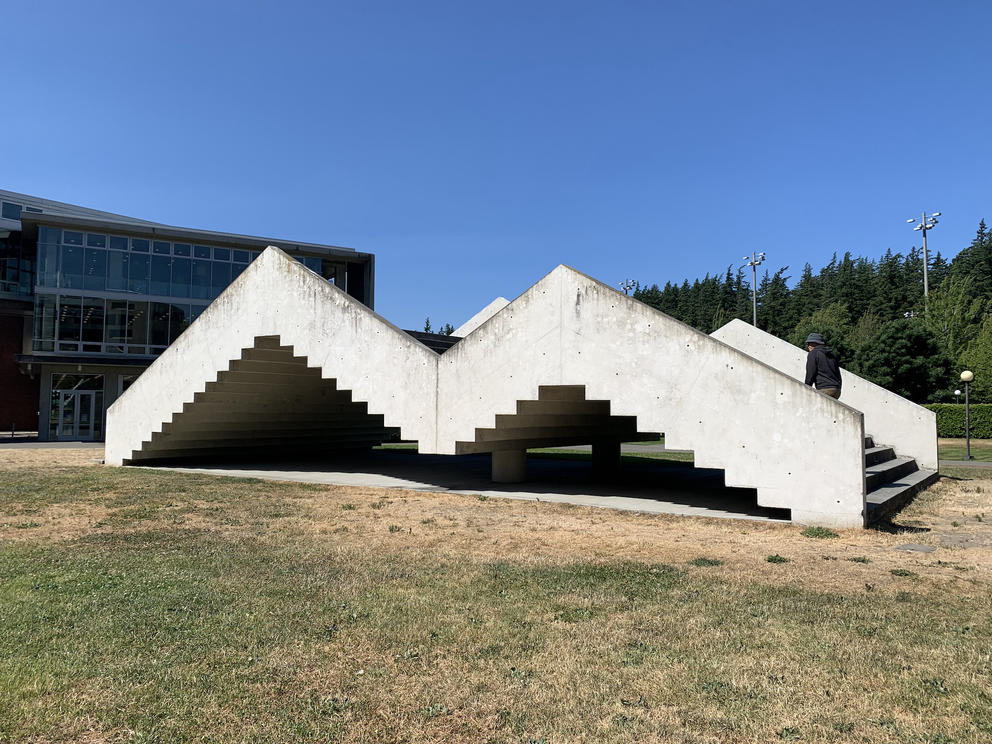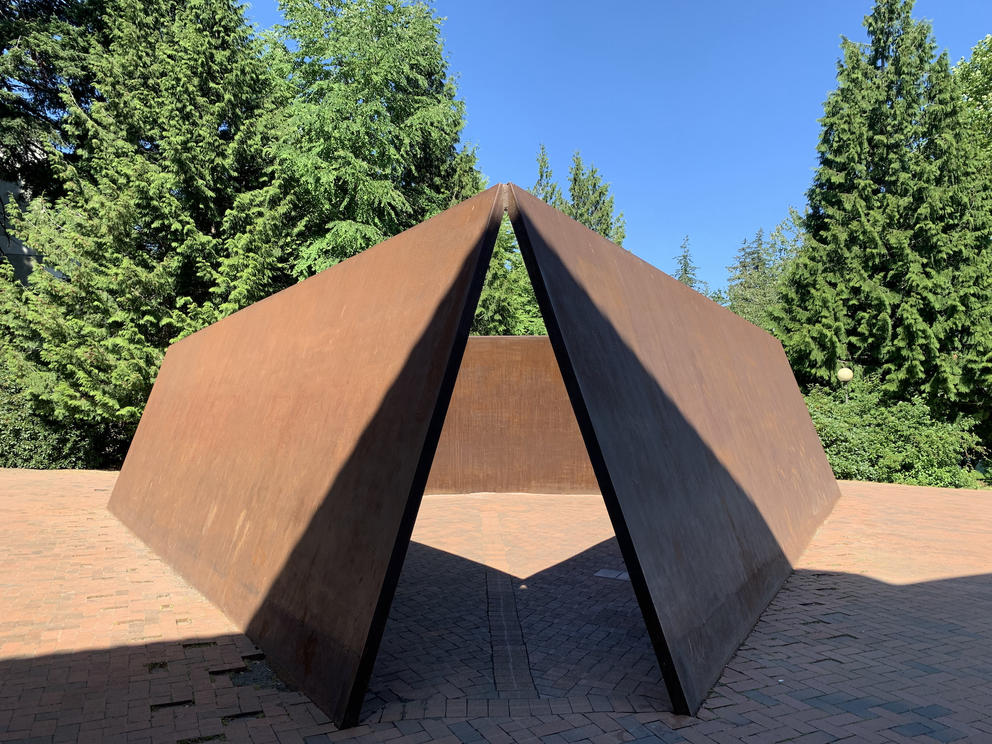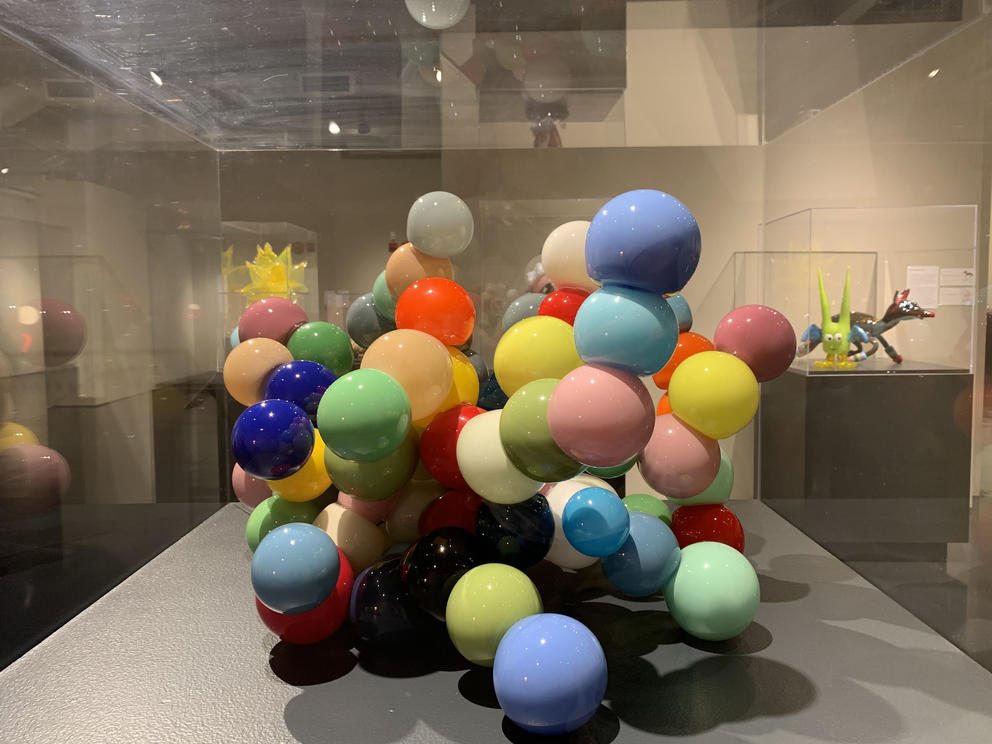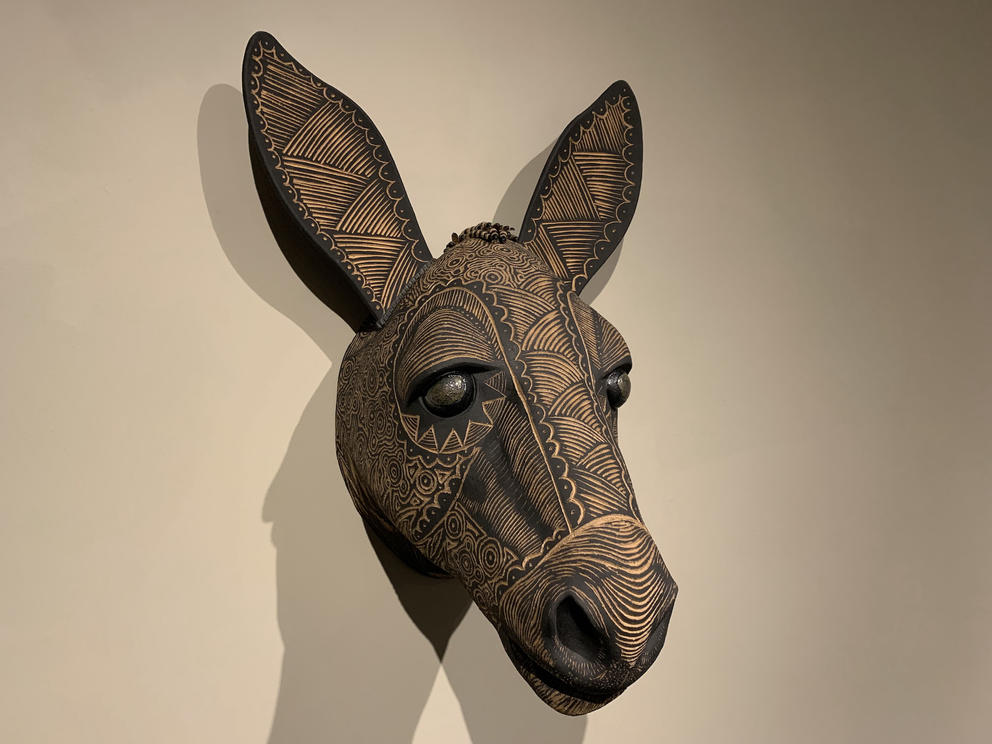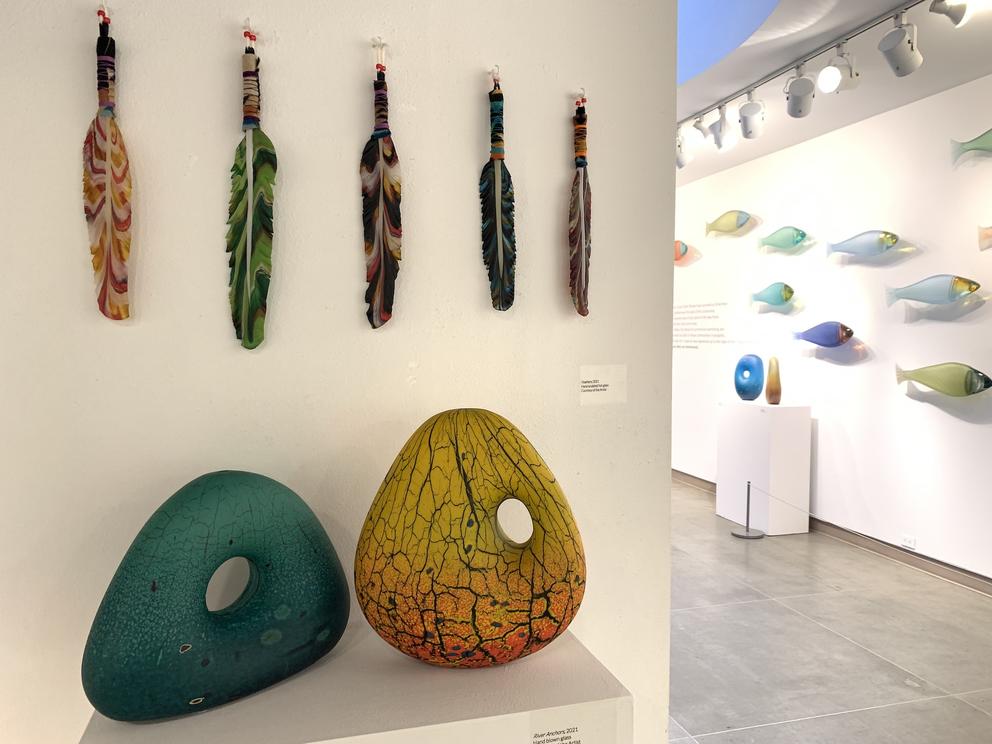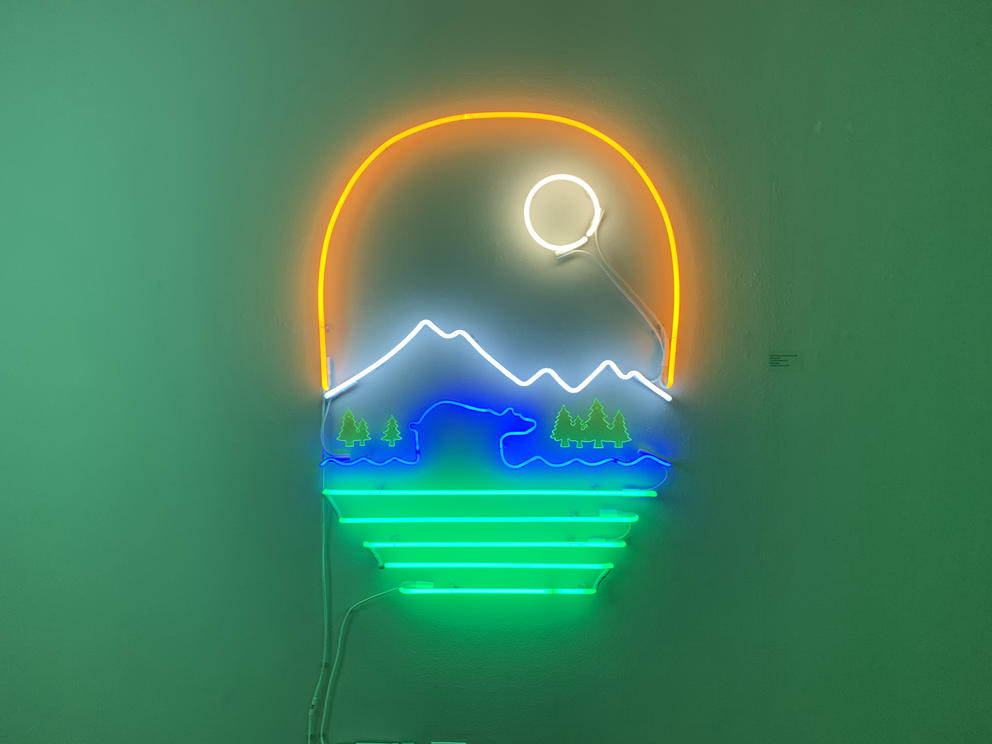The idea was a classic summer road trip — just add art. I had sketched out a plan that was admittedly less freewheeling than mad dash, aiming to visit an array of arts and cultural venues just north of Seattle. My companion: husband Daniel. Our vehicle: a VW van. The goal: a dozen stops in two days.
Cascadia Art Museum in Edmonds: Just south of the ferry landing, about 25 minutes from Seattle
That fragrant Edmonds parking lot belongs to Cascadia Art Museum, a barrel-roofed former 1960s Safeway cleverly transformed into an airy series of galleries, with a neighboring distillery and bistro. Out front, lush floral landscaping beckons visitors into the space, where the emphasis is on Northwest artists who created between the late-19th and mid-20th centuries.
Part of Cascadia’s mission is to “rescue and elevate the reputations of forgotten figures who deserve to be remembered.” So, in addition to seeing art by Northwest luminaries — such as painters Mark Tobey, Kenneth Callahan and Dorothy Dolph Jensen, photographer Imogen Cunningham and sculptor Charles W. Smith — much of the enjoyment here is in seeing wonderful pieces by lesser-known artists.
For me, this was especially the case with the exhibit Origins: Northwest Abstract Art 1920-1960 (through Oct. 10), which includes a large group of works by Oregon artist Maude I. Kerns. Her lively abstract paintings from the 1950s pulled me in like a tractor beam with their far-out Jetsons vibe. Also on view through Oct. 10: Painted with Light: Northwest Pictorialist Photography, 1910-1930; and don’t miss the well-curated gift shop.
Bonus: If you’ll be in Edmonds on Aug. 14, grab tix for the groovetastic Delvon Lamarr Trio, playing two afternoon shows outside the Edmonds Center for the Arts.
Schack Art Center in Everett: about 30 minutes from Edmonds; 30 minutes from Seattle
One stop in and we were already running 30 minutes late, according to my rigid schedule. We hightailed it back to I-5 north, where we encountered the ever-present Mysterious Everett Slowdown, but made it through the traffic to our destination: the Schack Art Center in Everett’s Historic District.
Bustling with visitors when we arrived, this multipurpose arts space has classrooms, a gift shop with artist-made goods, a hotshop where glassblowers are visible through a wide window, and a welcoming gallery space. As we walked in, Lee Woodfin’s “The Dimming,” a hanging, rotating sculpture made of recycled materials, including bike inner tubes and VHS tapes, appeared to kick up its heels (old floppy disks) to Van Halen’s “Panama,” audible from the hotshop speakers.
Woodfin’s piece was part of the 22nd Biennial Juried Show, which has since closed. Now the gallery is featuring evocative impasto landscapes by Anacortes painter Alfred Currier (through Sept. 11), which sing with the colors of Skagit Valley.
I hadn’t realized there were so many outdoor sculptures in this part of Everett (check out the art map), but you can find giant pencils, giant books, giant puzzle pieces, plus metal sculptures by master carver James Madison (Snohomish/Tlingit), including his timely “Bear and Eagle Protecting the Last of the Native Salmon.”
Bonus: Everett has two new outdoor music series in August: Music at the Marina (including the Dusty 45s and Leroy Bell); and Dick’s Drive-In Summer Series (including the Moondoggies and Shaina Shepherd).
Tulalip Tribes Hibulb Cultural Center: about 15 minutes from Everett; 40 minutes from Seattle
We didn’t know it yet, but we’d soon encounter another of James Madison’s artworks. After a brief stint back on I-5 north (our stomachs starting to growl from poor snack planning), we exited toward the Hibulb Cultural Center on the Tulalip Reservation.
Sited on 50 acres of forest and wetlands, the voluminous building is packed with art, artifacts and history. It starts in the grand canoe hall with two tall cedar welcome figures, one of which is a woman wearing a kerchief and carrying a basket of clams. James Madison carved it from a fallen tree in the image of his great-grandmother.
Exhibits also address contemporary concerns of the Tulalip peoples, including the painful legacy of lost traditions and language that resulted from the deliberate eradication of culture in boarding schools at the turn of the 19th century.
The current exhibit, The Power of Words: A History of Tulalip Literacy, includes a history of the Lushootseed alphabet (developed in the 1960s), initiatives for language preservation and an exact replica of the Treaty of Point Elliott of 1855, that founding document of the Pacific Northwest, which remains a living text still used in legal cases determining Native sovereignty.
Knowing what we do about the deceptive nature of the treaty, it’s a gut punch to see the “X’s” signed by the regional chiefs. The exhibit explains how the treaty experience sparked new thinking among the Coast Salish tribes regarding the role of literacy and written language in self-preservation.
Mount Vernon: about 15 minutes from Tulalip; 1 hour from Seattle
Back on I-5, I watched Mount Baker’s notched and snow-covered profile grow larger as we continued north. Pulling into Mount Vernon, we headed straight to the Skagit Food Co-op to grab a long-delayed lunch. After a post-sandwich stroll down the lovely Skagit Riverwalk, we checked out the small, simple Perry and Carlson gallery, open since late 2020.
Attached to a home goods shop full of lovely things I had no idea I desired (hand-carved cocktail tools, a brass soap dish), the storefront gallery is appealingly informal, with raw floors and a big sunny window. When I visited, the room came alive with big, boldly hued paintings by Northwest notable William Slater (1939-2007), who hung out with Mark Rothko and Jasper Johns before moving to Skagit Valley in the 1970s.
The new show (through Aug. 30) is a combined effort of renowned Northwest father/son Seattle artists Mike Spafford and Spike Mafford. During a trip to Greece, Mafford photographed the landscapes where the 12 Labors of Hercules may well have occurred; once back home, Spafford painted his signature Greco-Roman silhouettes on the photos. An “epic” endeavor indeed.
At this point I had started shedding stops on my agenda like sandbags from a rising hot air balloon. We didn’t make it to Bitters Co., which operates out of a picturesque red barn about six miles west of Mount Vernon. But this month, the sister-owners are hosting W(h)ither the Garden (though Aug. 13), an ephemeral installation by Northwest artist Sarah Jones featuring translucent curtains, delicately embroidered with floral forms, that sway in the barny breeze.
Bonus: The next two installments of Valley Made Market, a popular pop-up artisan fair on Mount Vernon’s Main Street, are Aug. 22 and Sept. 19.
Edison: about 20 minutes from Mount Vernon; 1.5 hours from Seattle
It was late afternoon and I had planned far too much, but I was determined to stop by tiny Edison, always an enjoyable jaunt. The two-block-long stretch of food establishments (BreadFarm! Slough Food! Tweets!) and art galleries never fails to inspire dreams of running away to live a boho lifestyle.
We stopped in at i.e. Gallery to see longtime Seattle artist Sheila Klein’s Flags and Monuments. These clever weavings have moved on, and this month the gallery shifts to Plant Ghosts (through Aug. 29), by Robin Green, whose layered silk pieces look like maps of dried out civilizations, her ceramic vessels like artifacts unearthed therein.
Housed in a historic schoolhouse, Smith and Vallee Gallery is just down the street (as is everything in Edison). The exhibit of ceramic vessels I saw has been replaced with Fragile (through Aug. 29), a group show of glass objects rooted in nature, including work by Dan Friday, Raven Skyriver, Rik Allen and Shelley Muzylowski Allen. (It’s one of the farther flung shows in the Seattle Deconstructed Art Fair.)
No stop in Edison is complete without a dive into The Lucky Dumpster. It doesn’t have a great website and isn’t on Instagram, so if you haven’t been you’ll just have to trust me that it’s a treasure trove of locally made ceramics and jewelry and delightfully weird what-have-you.
If you’re into funky pottery, this is the place, with handmade vessels, plates, objets d’art and animal shapes. A child of the 1970s, I couldn’t resist buying a “claysette,” one of Anacortes artist Catherine Cougan’s ceramic replicas of cassette tapes.
After pulling over for blueberry popsicles at Bow Hill Blueberry Farm nearby, we headed to our HipCamp car-camping site, planning to trade art for nature for a few hours. It almost worked. But when the friendly camp host learned my occupation, she ran into her house and brought out something she thought I’d enjoy: a book of Northwest art.
Western Washington University: about 30 minutes from Edison
On Day 2 of the journey, I aimed for a more realistic, possibly even relaxed approach to arts road tripping. First on the agenda was a hearty breakfast in Fairhaven at artful coffee shop Café Blue. In addition to serving delectable food, co-owner Lily Lovell makes the café’s lovely pottery dishware and sells locally made ceramics and jewelry on the premises.
I was feeling cozy at the café, but we had to get going since I wanted to check out something I’d noted on a brown highway sign: the Western Washington University Sculpture Park. I figured it’s always good to stretch the legs, and maybe there would be a handful of interesting works. But as soon as we started looking at the campus map, I realized this sculpture park is a very big deal (and would likely throw my schedule out the window).
We strolled the pretty green campus and encountered piece after piece by legends of contemporary art: Donald Judd, Isamu Noguchi, Nancy Holt, Mark di Suvero, Bruce Nauman, Magdalena Abakanowicz, James FitzGerald. I was particularly taken by Holt’s “Stone Enclosure: Rock Rings” (1977-78). Circling round and round through the cobblestone walls felt hypnotic, like an ancient ritual. Whereas climbing the steep bleacherlike steps of Nauman’s “Stadium Piece” (1979-80) brought a feeling of stunted triumph — rising upward only to come right back down.
While walking amid the thrilling array, I passed a young campus tour guide talking to a gaggle of prospective students and their parents. “This is some more art,” she said, gesturing limply toward a huge, rusted and angular sculpture. “I don’t know what it is.” It was all I could do not to interject, “That’s a Richard Serra!” But the surge of frustration I felt was perhaps more about my own cluelessness, having never known this collection existed just a couple of hours north.
Bellingham: about 2 hours from Seattle
High on exceptional outdoor art, we drove into downtown Bellingham to swing by the recently opened Geheim Gallery, a storefront space for contemporary art. Next door, a lazy groove emanated from Black Noise Records, where a vigilant corgi kept watch on the street activity from an apartment window above. Geheim’s next show is Future Memory (through Aug. 22), by Bellingham-based artist Lisa Turner, whose watery pastel screen prints combine flora, crushed bottles and intestinal twists.
After lunch at one of the city’s plentiful breweries, we walked over to the Whatcom Museum’s Lightcatcher Building. Currently on view is El Zodiaco Familiar (through Oct. 24), a delightful new exhibit by Seattle-based ceramic sculptor George Rodriguez.
The show consists of 12 oversized animal heads mounted on the walls — each representing a character of the Chinese zodiac, which Rodriguez has translated into analogous animals from Mexican folklore. He has pursued this narrative in previous work — but this time there’s a shift.
Rodriguez collaborated with 13 Mexican and ChicanX/Chincane artists, each of whom brings their own aesthetic traditions to the mix. My favorite among these magical creatures included a monkey whose vividly colored face is an exquisite “yarn painting,” a burro head carved like a woodblock print and a deer with a woven snout.
Also on view through Oct. 24: Fluid Formations, a packed group show of glass art from local pros, including: Preston Singletary’s totemic raven tower; Jen Elek’s burbling bubblegum balls; a chartreuse flying saucer vessel by Benjamin Moore (who passed away earlier this summer); and a translucent bear and Lummi basket pattern by Dan Friday. Meanwhile upstairs, People of the Sea and Cedar: A Journey through the Tribal Cultures and History of the Northwest Coast is ongoing.
La Conner: about 50 minutes from Bellingham along the scenic route (30 minutes on I-5); 1 hour and 15 minutes from Seattle
We took the scenic route from Bellingham to La Conner, along Chuckanut Drive, where the thick foliage hugs the road then releases suddenly into operatic views of Samish Bay. As we descended into the wide, flat expanse of Skagit Valley, my eyes started to play tricks on me, exhibiting abstract art everywhere — in the big marshmallows of baled hay dotting pale green fields, in the variegated red-rose-salmon slats of a faded barn, in the unusual patterns on a Holstein’s flank.
When we pulled into La Conner, my traveling companion cried uncle: “Please, no more art,” Daniel said. “I can’t see any more.” I understood. Only the strong can survive this much art-seeing, so reader, proceed at your own risk (and reward).
But I wasn’t leaving without visiting the Museum of Northwest Art, where Seattle-based glass artist Dan Friday has created an incredible new solo show, Future Artifacts (through Nov. 14). In his artist statement, Friday laments that much of the physical evidence of his ancestral Lummi heritage has disintegrated, because cedar baskets, wool blankets, reef nets and totem poles were made of natural materials. With a variety of glass forms, he aims to tell the story of his people in what he hopes is a more lasting medium — to serve, metaphorically, as “a contemporary painting on the cave wall,” he writes.
It’s a colorful, expansive show: glass replicas of the stone anchors used in reef netting, a huge school of glass fish and historical photos of family members — such as his great-great-grandfather Frank Hillaire (Xe Tel Ek), one of the signers of the Point Elliott Treaty. Friday also invited contemporary Coast Salish weavers to create a series of gorgeous wool garments with ancestral techniques and patterns. My husband, after getting his second wind, was happy to have changed his mind and come inside.
One last look from the La Conner waterfront and we’d be on our way home. Across the Swinomish Channel, on the shore of the Swinomish Village, you can see the three striking pavilions of Swadabs Park. Built in 2011 to resemble traditional Coast Salish cedar hats tilted up at a welcoming angle, they reminded me that art has forever been a staple of this region — inviting us to open our minds and expand our sense of home.
Get the latest in local arts and culture
This weekly newsletter brings arts news and cultural events straight to your inbox.

